PORSCHE 911 GT3 2004 5.G User Guide
Manufacturer: PORSCHE, Model Year: 2004, Model line: 911 GT3, Model: PORSCHE 911 GT3 2004 5.GPages: 195, PDF Size: 16.94 MB
Page 11 of 195

Setting andoperating vehicle
components whendriving
A
Warning!
There isadanger ofaccident ifyou setorop-
erate theon-board computer, radio,naviga-
tion system, telephone orother equipment
when driving.
This could distract youfrom thetraffic and
cause youtolose control ofthe vehicle.
t> Operate thecomponents whiledriving onlyif
the traffic situation allowsyoutodo sosafely.
t>
Carry outany complicated operatingorsetting
procedures onlywiththevehicle stationary.
10
Portable
FuelContainers
A
Danger!
Portable fuelcontainers, fullorpartially
empty, mayleak, causing anexplosion, or
result infire incase ofan accident.
t> Never carryadditional fuelinportable contain-
ers inyour vehicle.
Engine
Exhaust
A
Danger!
Engine exhaust isdangerous ifinhaled.
Engine exhaust fumeshavemany compo-
nents which youcansmell. Theyalsocontain
carbon monoxide (CO),which isacolorless
and odorless gas.
Carbon monoxide cancause unconscious-
ness andeven death ifinhaled.
t> Never startorlet the engine runinan en-
closed, unventilated area.
It is not recommended tosit inyour carforpro-
longed periods withtheengine onand thecar
not moving.
Page 12 of 195
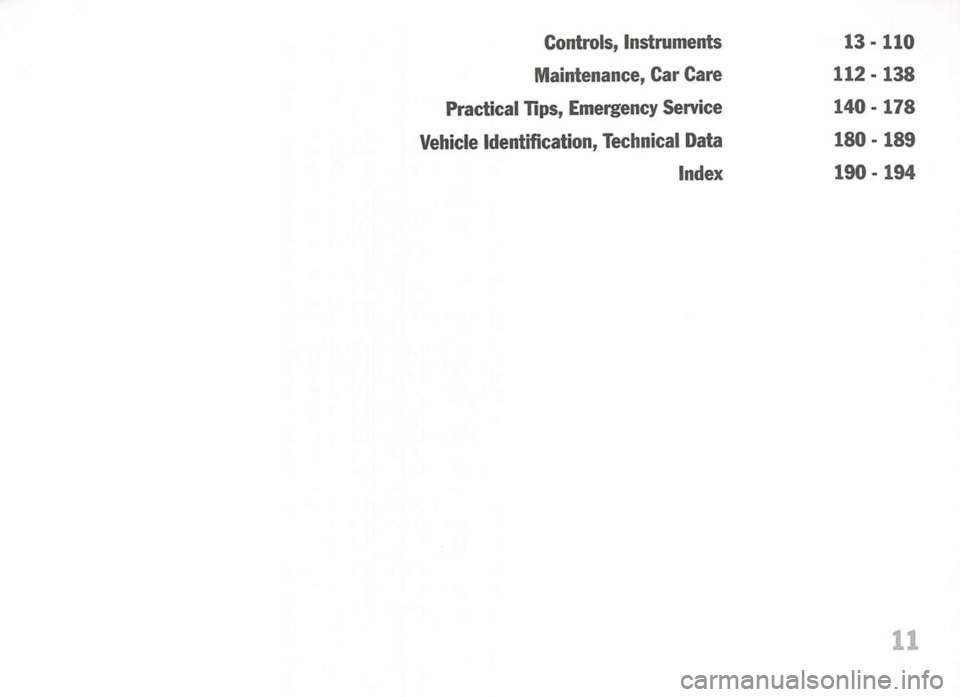
Controls,Instruments
Maintenance, CarCare
Practical Tips,Emergency Service
Vehicle Identification, TechnicalData
Index
13
-110
112 -138
140 -178
180 -189
190 -194
11
Page 13 of 195

12
Page 14 of 195
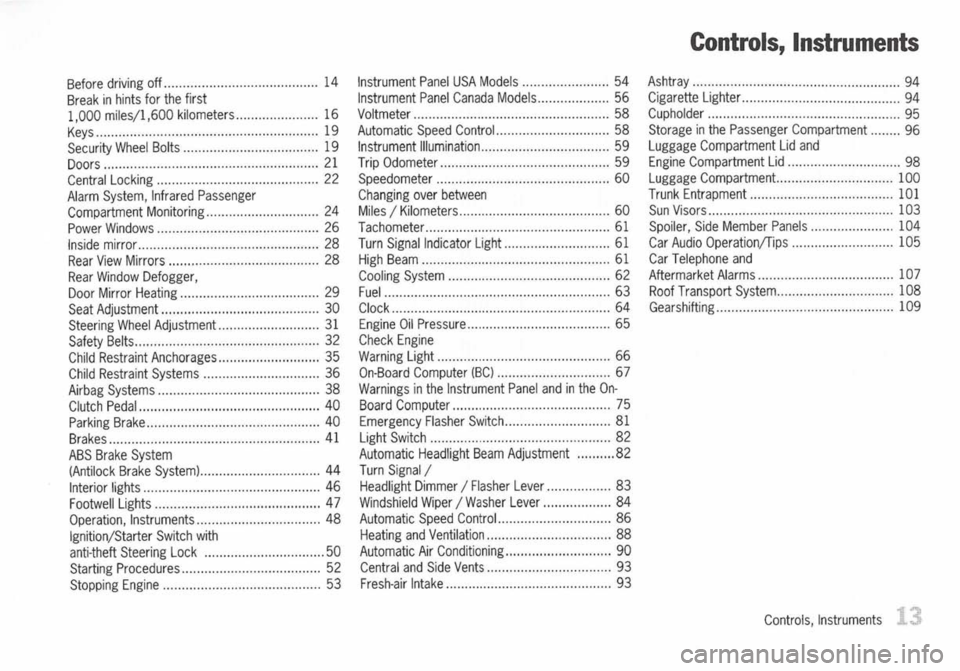
Beforedrivingoff.. 14
Break inhints forthe first
1,000 miles/1,600 kilometers 16
Keys 19
Security WheelBolts 19
Doors 21
Central Locking 22
Alarm System, InfraredPassenger
Compartment Monitoring 24
Power Windows 26
Inside mirror 28
Rear View Mirrors 28
Rear Window Defogger,
Door Mirror Heating 29
Seat Adjustment 30
Steering WheelAdjustment.. 31
Safety Belts 32
Child Restraint Anchorages 35
Child Restraint Systems 36
Airbag Systems 38
Clutch Pedal 40
Parking Brake 40
Brakes 41
ABS Brake System
(Antilock BrakeSystem) 44
Interior lights 46
Footwell Lights 47
Operation, Instruments 48
Ignition/Starter Switchwith
anti-theft SteeringLock 50
Starting Procedures 52
Stopping Engine 53Instrument
PanelUSAModels 54
Instrument PanelCanada Models 56
Voltmeter 58
Automatic SpeedControl 58
Instrument Illumination 59
Trip Odometer 59
Speedometer 60
Changing overbetween
Miles /Kilometers 60
Tachometer 61
Turn Signal Indicator Light 61
High Beam 61
Cooling System 62
Fuel 63
C~k ~
Engine OilPressure 65
Check Engine
Warning Light 66
On-Board Computer (BC) 67
Warnings inthe Instrument Panelandinthe On-
Board Computer 75
Emergency FlasherSwitch 81
Light Switch 82
Automatic HeadlightBeamAdjustment 82
Turn Signal /
Headlight Dimmer/Flasher Lever 83
Windshield Wiper/Washer Lever 84
Automatic SpeedControl 86
Heating andVentilation 88
Automatic AirConditioning 90
Central andSide Vents 93
Fresh-air Intake 93Controls,
Instruments
Ashtray 94
Cigarette Lighter 94
Cupholder 95
Storage inthe Passenger Compartment 96
Luggage Compartment Lidand
Engine Compartment Lid 98
Luggage Compartment.. 100
Trunk Entrapment 101
Sun Visors 103
Spoiler, SideMember Panels 104
Car Audio Operation/Tips 105
Car Telephone and
Aftermarket Alarms 107
Roof Transport System 108
Gearshifting 109
Controls, Instruments
Page 15 of 195

DearPorsche Owner
A lot has gone intothemanufacture ofyour
Porsche, includingadvanced engineering, rigid
quality control anddemanding inspections.
These engineering andsafety features willbe
enhanced byyou ...
the safe driver ...
- who knows hiscar and allcontrols,
- who maintains thevehicle properly,
- who uses driving skillswisely andalways
drives withinher/his owncapabilities andthe
level offamiliarity withthevehicle.
You willfind helpful hintsinthis manual onhow to
perform mostofthe checks listedonthe following
pages.
If in doubt, havethese checks performed byyour
authorized Porschedealer.
Controls, Instruments
Before
driving off...
Check thefollowing itemsfirst
I>
Turn theengine offbefore youattempt any
checks orrepairs onthe vehicle.
I>
Besure thetires areinflated correctly.
Check tiresfordamage andtirewear.
I>
See that wheel boltsareproperly tightened
and notloose ormissing.
I>
Check engine oillevel, addifnecessary.
Make itahabit tohave engine oilchecked with
every fuelfilling.
I>
Check allfluid levels suchaswindshield
washer andbrake fluidlevels.
I>
Besure thevehicle battery iswell charged and
cranks theengine properly.
I>
Check alldoors andlidsforproper operation
and latch them properly.
I>
Check, andifnecessary replacewornor
cracked wiperblades.
I>
See that allwindows areclear andunob-
structed.
I>
Check airintake slotsandarea between lug-
gage compartment lidand windshield arefree
of snow andice,sothe heater andthewind-
shield wipers workproperly.
I>
Ifachild willberiding inthe vehicle, check
child seat/child seatrestraint systemtoen-
sure thatrestraints areproperly adjusted.
I>
Check allexterior andinterior lightsforopera-
tion andthat thelenses areclean.
I>
Check theheadlights forproper aim,andif
necessary, havethem adjusted.
I>
Check underthevehicle forleaks.
I>
Besure allluggage isstowed securely.
Emergency equipment
It is good practice tocarry emergency equipment
in your vehicle.
Some ofthe items youshould haveare:
window scraper, snowbrush, container orbag of
sand orsalt, emergency light,small shovel, first-
aid kit, etc.
Page 16 of 195
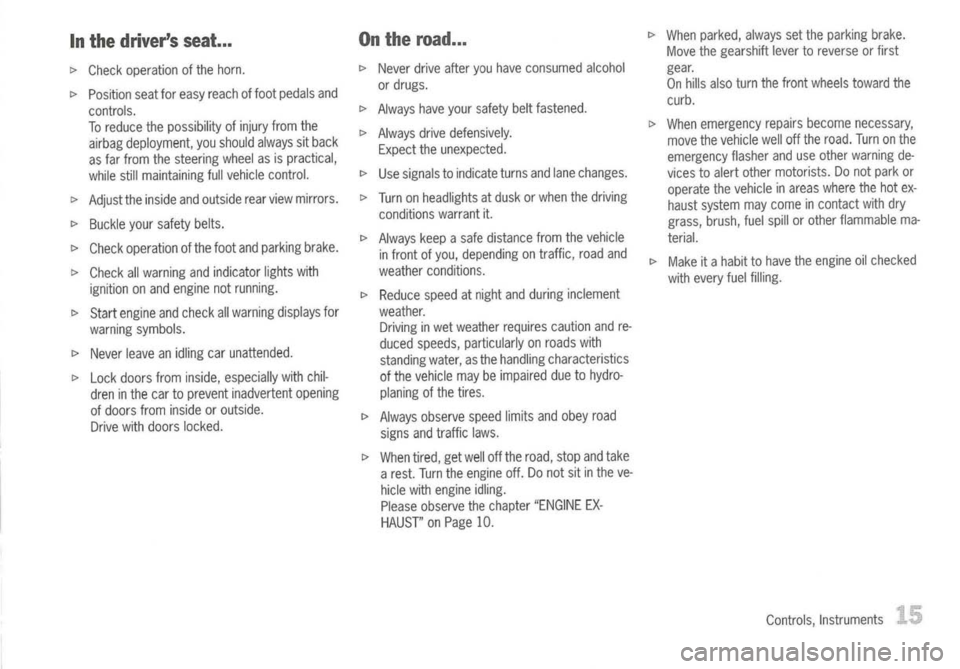
Inthe driver's seat...
c>
Check operation ofthe horn.
c>
Position seatforeasy reach offoot pedals and
controls.
To reduce thepossibility ofinjury fromthe
airbag deployment, youshould always sitback
as far from thesteering wheelasispractical,
while stillmaintaining fullvehicle control.
c>
Adjustthe insideandoutside rearview mirrors.
c>
Buckle yoursafety belts.
C>
Check operation ofthe foot andparking brake.
C>
Check allwarning andindicator lightswith
ignition onand engine notrunning.
C>
Start engine andcheck allwarning displays for
warning symbols.
C>
Never leaveanidling carunattended.
C>
Lock doors frominside, especially withchil-
dren inthe cartoprevent inadvertent opening
of doors frominside oroutside.
Drive withdoors locked.
On
the road ...
C>
Never driveafteryouhave consumed alcohol
or drugs.
C>
Always haveyoursafety beltfastened.
C>
Always drivedefensively.
Expect theunexpected.
C>
Use signals toindicate turnsandlane changes.
C>
Turn onheadlights atdusk orwhen thedriving
conditions warrantit.
C>
Always keepasafe distance fromthevehicle
in front ofyou, depending ontraffic, roadand
weather conditions.
C>
Reduce speedatnight andduring inclement
weather. Driving inwet weather requirescautionandre-
duced speeds, particularly onroads with
standing water,asthe handling characteristics
of the vehicle maybeimpaired duetohydro-
planing ofthe tires.
C>
Always observe speedlimitsandobey road
signs andtraffic laws.
C>
When tired,getwell offthe road, stopandtake
a rest. Turntheengine off.Donot sitinthe ve-
hicle withengine idling.
Please observe thechapter "ENGINE EX-
HAUST" onPage 10.
C>
When parked, alwayssetthe parking brake.
Move thegearshift levertoreverse orfirst
gear.
On hills also turnthefront wheels towardthe
curb.
C>
When emergency repairsbecome necessary,
move thevehicle welloffthe road. Turnonthe
emergency flasheranduseother warning de-
vices toalert other motorists. Donot park or
operate thevehicle inareas where thehotex-
haust system maycome incontact withdry
grass, brush,fuelspill orother flammable ma-
terial.
C>
Make itahabit tohave theengine oilchecked
with every fuelfilling.
Controls, Instruments
Page 17 of 195
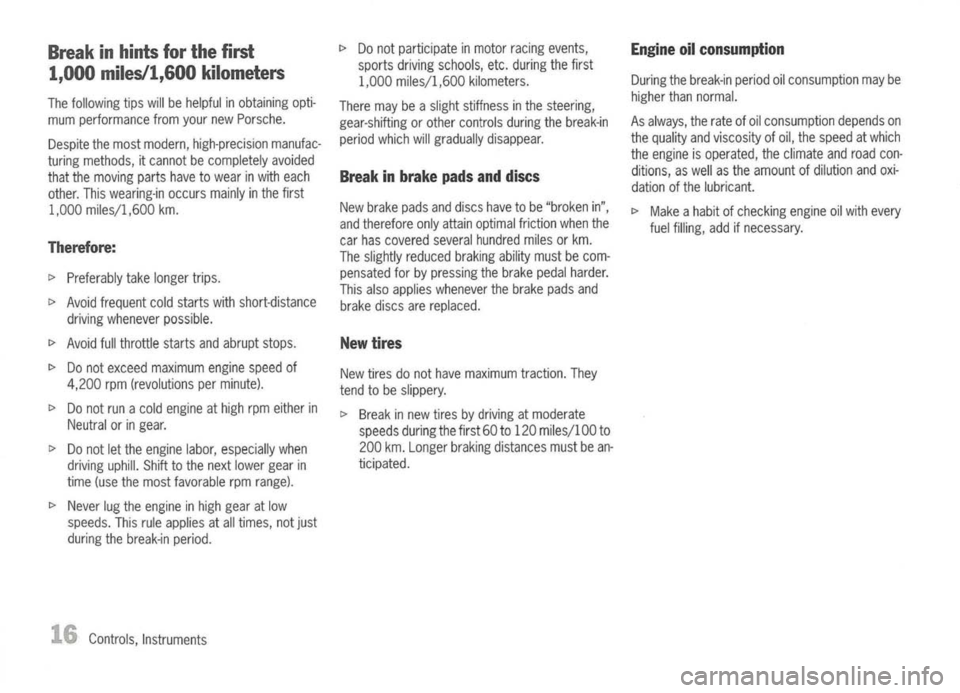
Break inhints forthe first
1,000 miles/l,600 kilometers
The following tipswillbehelpful inobtaining opti-
mum performance fromyournewPorsche.
Despite themost modern, high-precision manufac-
turing methods, itcannot becompletely avoided
that themoving partshavetowear inwith each
other. Thiswearing-in occursmainlyinthe first
1,000 milesj1,600 km.
Therefore:
I>
Preferably takelonger trips.
I>
Avoid frequent coldstarts withshort-distance
driving whenever possible.
I>
Avoid fullthrottle startsandabrupt stops.
I>
Donot exceed maximum enginespeedof
4,200 rpm(revolutions perminute).
I>
Donot run acold engine athigh rpmeither in
Neutral oringear.
I>
Donot letthe engine labor,especially when
driving uphill.Shifttothe next lower gearin
time (usethemost favorable rpmrange).
I>
Never lugthe engine inhigh gear atlow
speeds. Thisruleapplies atall times, notjust
during thebreak-in period.
Controls, Instruments
I>
Donot participate inmotor racing events,
sports driving schools, etc.during thefirst
1,000 milesj1,600 kilometers.
There maybeaslight stiffness inthe steering,
gear-shifting orother controls duringthebreak-in
period whichwillgradually disappear.
Break inbrake padsanddiscs
New brake padsanddiscs havetobe "broken in",
and therefore onlyattain optimal frictionwhenthe
car has covered severalhundred milesorkm.
The slightly reduced brakingabilitymustbecom-
pensated forbypressing thebrake pedalharder.
This alsoapplies whenever thebrake padsand
brake discsarereplaced.
New tires
New tires donot have maximum traction.They
tend tobe slippery.
I>
Break innew tires bydriving atmoderate
speeds duringthefirst 60to120 milesj1 00to
200 km.Longer braking distances mustbean-
ticipated.
Engine
oilconsumption
During thebreak-in periodoilconsumption maybe
higher thannormal.
As always, therate ofoil consumption dependson
the quality andviscosity ofoil, the speed atwhich
the engine isoperated, theclimate androad con-
ditions, aswell asthe amount ofdilution andoxi-
dation ofthe lubricant.
I>
Make ahabit ofchecking engineoilwith every
fuel filling, addifnecessary.
Page 18 of 195
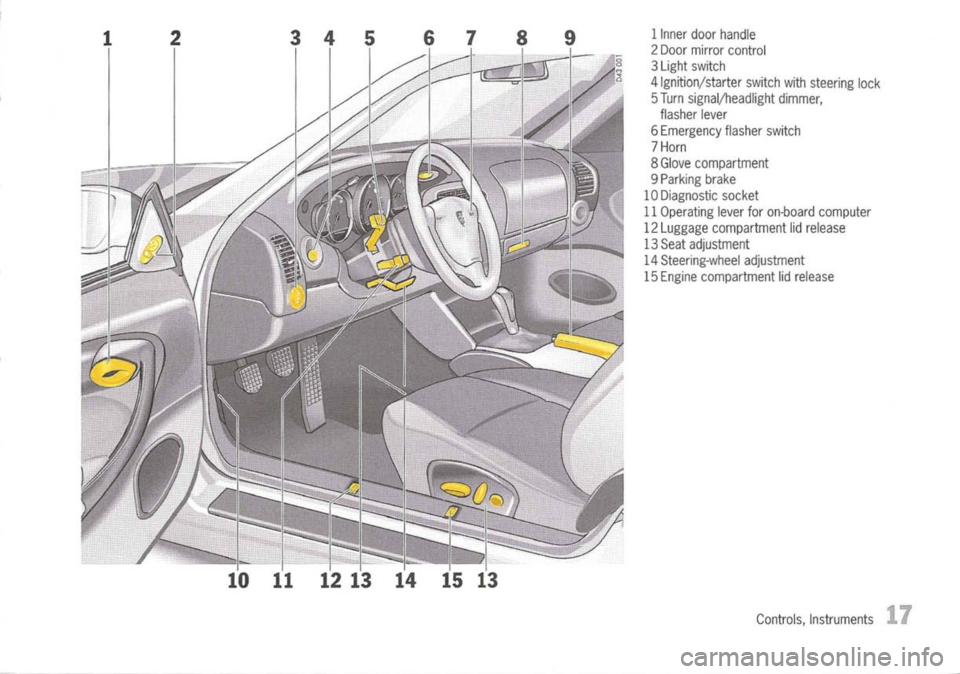
1Inner doorhandle
2 Door mirror control
3 Light switch
4 Ignition/starter switchwithsteering lock
5 Turn signal/headlight dimmer,
flasher lever
6 Emergency flasherswitch
7 Horn
8 Glove compartment
9 Parking brake
10 Diagnostic socket
11 Operating leverforon-board computer
12 Luggage compartment lidrelease
13 Seat adjustment
14 Steering-wheel adjustment
15 Engine compartment lidrelease
Controls, Instruments
17
Page 19 of 195
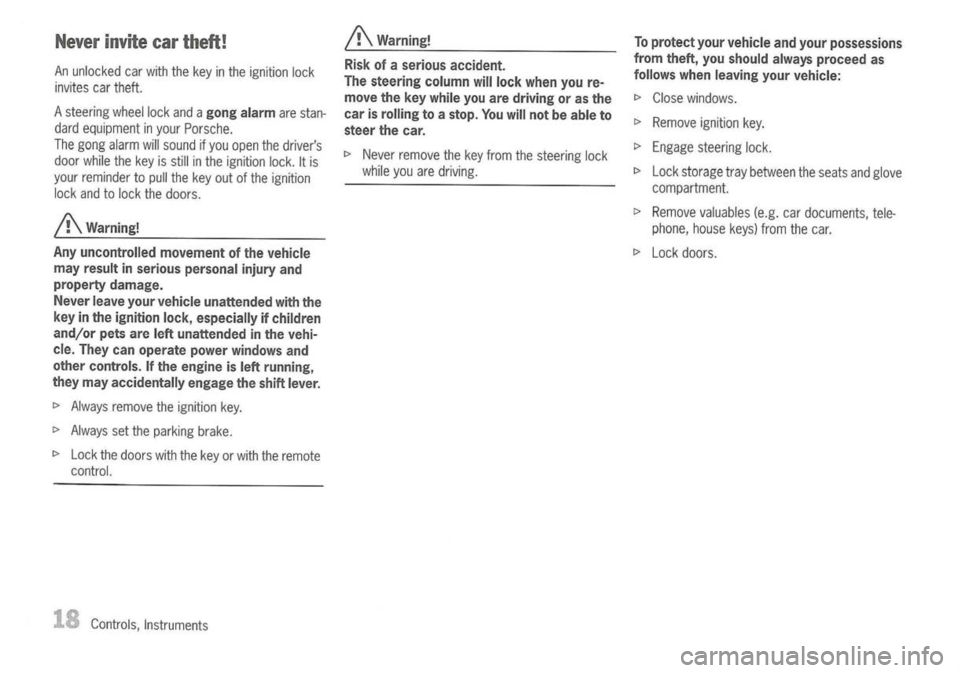
Neverinvitecartheft!
An unlocked carwith thekey inthe ignition lock
invites cartheft.
A steering wheellockanda
gong alarm
arestan-
dard equipment inyour Porsche.
The gong alarm willsound ifyou open thedriver's
door while thekey isstill inthe ignition lock.Itis
your reminder topull thekey outofthe ignition
lock andtolock thedoors.
/!\
Warning!
Any uncontrolled movementofthe vehicle
may result inserious personal injuryand
property damage.
Never leaveyourvehicle unattended withthe
key inthe ignition lock,especially ifchildren
and/or petsareleftunattended inthe vehi-
cle. They canoperate powerwindows and
other controls. Ifthe engine isleft running,
they mayaccidentally engagetheshift lever.
I>
Always remove theignition key.
I>
Always setthe parking brake.
I>
Lock thedoors withthekey orwith theremote
control.
Controls, Instruments
/!\
Warning!
Risk ofaserious accident.
The steering column
willlock
when youre-
move thekey while youaredriving oras the
car isrolling toastop. Youwillnotbeable to
steer thecar.
I>
Never remove thekey from thesteering lock
while youaredriving.
To
protect yourvehicle andyour possessions
from theft, youshould alwaysproceed as
follows whenleaving yourvehicle:
I>
Close windows.
I>
Remove ignitionkey.
I>
Engage steering lock.
I>
Lock storage traybetween theseats andglove
compartment.
I>
Remove valuables (e.g.cardocuments, tele-
phone, housekeys)fromthecar.
I>
Lock doors.
Page 20 of 195
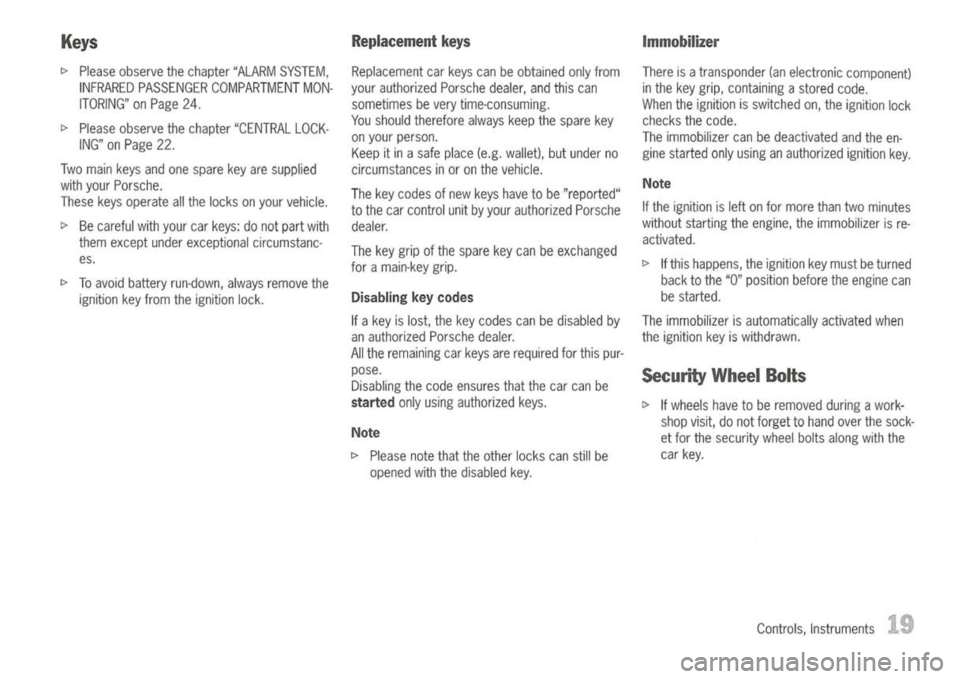
Keys
I>
Please observe thechapter "ALARM SYSTEM,
INFRARED PASSENGER COMPARTMENT MON-
ITORING" onPage 24.
I>
Please observe thechapter "CENTRAL LOCK-
ING" onPage 22.
Two main keysandonespare keyaresupplied
with your Porsche.
These keysoperate allthe locks onyour vehicle.
I>
Becareful withyour carkeys: donot part with
them except underexceptional circumstanc-
es.
I>
Toavoid battery run-down, alwaysremove the
ignition keyfrom theignition lock.
Replacement
keys
Replacement carkeys canbeobtained onlyfrom
your authorized Porschedealer,andthis can
sometimes bevery time-consuming.
You should therefore alwayskeepthespare key
on your person.
Keep itin asafe place (e.g.wallet), butunder no
circumstances inor on the vehicle.
The keycodes ofnew keys have tobe "reported"
to the carcontrol unitbyyour authorized Porsche
dealer.
The keygrip ofthe spare keycan beexchanged
for amain-key grip.
Disabling keycodes
If a key islost, thekey codes canbedisabled by
an authorized Porschedealer.
All the remaining carkeys arerequired forthis pur-
pose.
Disabling thecode ensures thatthecar can be
started
onlyusing authorized keys.
Note
I>
Please notethattheother lockscanstillbe
opened withthedisabled key.
Immobilizer
There isatransponder (anelectronic component)
in the key grip, containing astored code.
When theignition isswitched on,the ignition lock
checks thecode.
The immobilizer canbedeactivated andtheen-
gine started onlyusing anauthorized ignitionkey.
Note
If the ignition isleft onfor more thantwominutes
without starting theengine, theimmobilizer isre-
activated.
I>
Ifthis happens, theignition keymust beturned
back tothe "0"position beforetheengine can
be started.
The immobilizer isautomatically activatedwhen
the ignition keyiswithdrawn.
Security WheelBolts
I>
Ifwheels havetobe removed duringawork-
shop visit,donot forget tohand overthesock-
et for the security wheelboltsalong withthe
car key.
Controls,Instruments
19